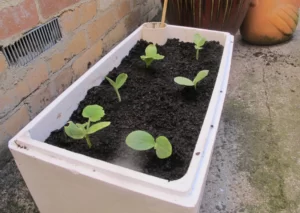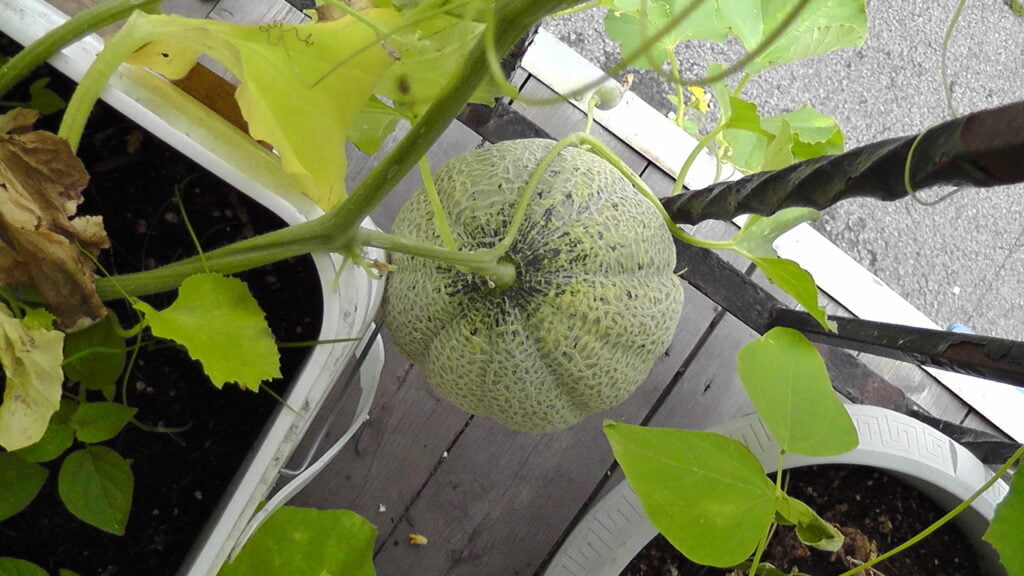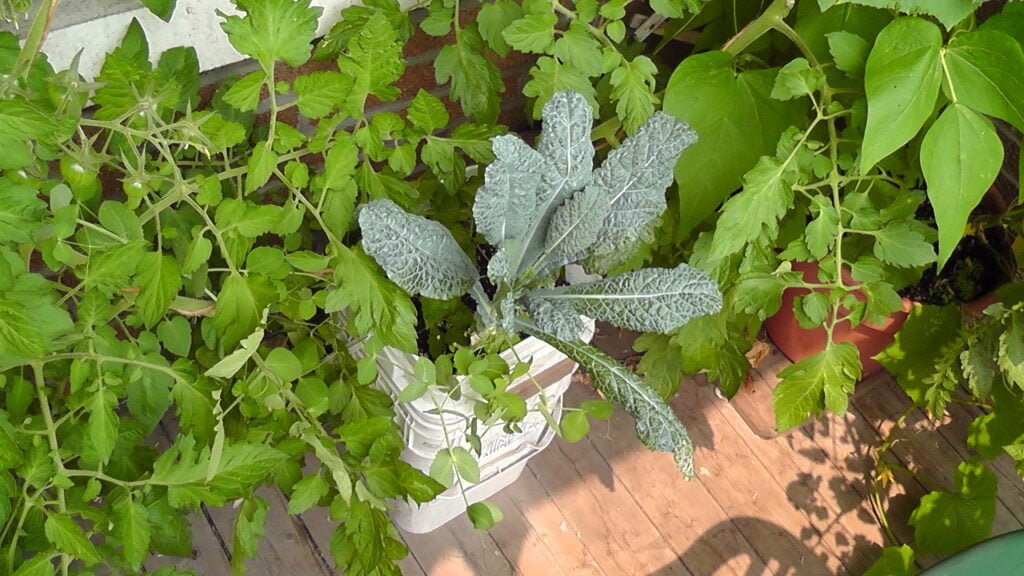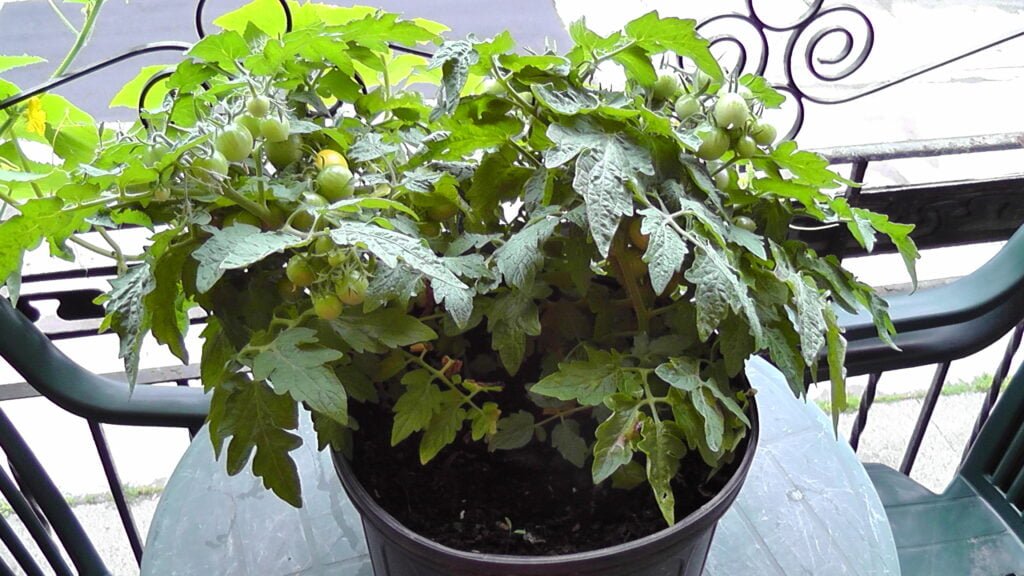Container gardening offers a versatile option for people living in city environments. They can be grown on balconies, rooftops, patios, concrete surfaces, contaminated lots, staircases, and suspended from fences, railings and ceilings.
Types of containers
Any container can be converted or recycled into an urban mini-garden: a bucket, an old garbage bin, a flower box or an old bath. You can also build larger boxes using wood–just avoid treated wood. It’s only a matter of what you have on hand, the space available and what money or time you want to invest. When growing food crops, you may want to concentrate on food-grade materials, such as reusing food-grade plastic buckets.
It can be especially advantageous to have a self-watering container, which has a double bottom which serves as a water reservoir. This means we don’t have to water the plant constantly on hot days. There are options for purchasing pre-made container gardens, though we encourage people to make their own container gardens from re-used materials. It’s much cheaper, more environmentally friendly, and can be a fun do-it-yourself project.
Building your own
Building your own container garden can be as simple as taking an old bucket, recycling bin, or garbage pail and drilling a few drainage holes in the bottom to avoid drowning the roots. In hot sunny weather you’ll need to water twice a day as it can dry out very quickly.
Building a self-watering container is a little more complicated, though well worth the results. Self-watering containers only need to be watered about 3 times a week (perhaps more during a heatwave) since they have an integrated water reservoir, allowing for much more independence as well as consistent access to water for the plants. To build your own, check out the do-it-yourself instructions from the project Urbanus Jardinus:
- how to build a self-watering container from reclaimed food-grade plastic buckets
- how to build a self-watering container from reclaimed styrofoam coolers and election signs


- how to build a balcony compost

Potting soil for container gardening
Starting out: People who are growing in city environments on balconies, rooftops, and concrete will need potting soil for container gardens. Ask around in your area to see if there are local sources. Otherwise, buy bagged soil from a gardening centre, avoiding soils that have added chemical fertilizers or manure (phone the companies if in doubt).
Going further: Save your potting soil from year to year! There is no need to change the soil—it just needs a boost of nutrients from compost. Each spring, empty the dirt from last year’s containers into a pile. For 3 parts dirt, add 1 part compost, mix it together, and re-fill your containers. This means that each year your total amount of “dirt” will grow because of the added compost: 3 containers becomes 4!
Fertility sources for containers
Much research still needs to be done about growing veganic food in container gardens. Indeed, most container gardeners use chemical-based or animal-based fertilizers because these products are easily available for purchase, though we can certainly garden in containers using an entirely plant-based approach. At the Veganic Agriculture Network, we’ve been growing a lush balcony garden in self-watering containers since 2009 with quite satisfying results.
In veganic gardening, fertility is typically maintained by feeding the soil food web with organic plant matter, and the microorganisms in the soil slowly break it down until it is accessible to the plants; however, container gardens have limited space and a smaller diversity of microorganisms compared to regular garden patches, so container gardening relies almost exclusively on direct feeding of the plants, such as adding mature compost, or liquid plant feeds like compost tea and comfrey tea.
For people living in the city, one of the best things you can do is to start composting, both to feed your gardens and reduce your environmental impact. No space at your place? You could join (or start!) a community compost program to compost with your neighbours. You can even produce your own compost in small spaces with a balcony compost, which can then be used to fertilize your other container gardens.
Another option for fertility is using your own urine, mixed with ten parts water, added once or twice a month. While not a plant-based technique per se, this is a way that city gardeners can work toward a closed system, boost their plants with nitrogen and potassium, and reduce their environmental impact by diverting their urine from the public water systems.
Growing conditions
Most plants can be grown in containers, though some are easier than others. Depending on the plant, the needs for nutrients, space, warmth and light will vary. Read on for more tips about the needs of different plants. But most importantly, you’ll learn more with practice, so dig in, and learn each year from your set-backs and successes.
Nutrient needs and watering needs
Fruit-bearing plants have much higher nutrient needs (remember, in botanical terms, tomatoes, eggplant, and cucumbers are all fruits!) They will often need a boost of nutrients mid-season, such as a cup of compost added to the surface of the soil, or an application of compost tea. In general, if the leaves of your plants begin to turn yellow, an application of compost should be helpful. Also keep in mind that plants access many nutrients with the help of water, so regular watering is essential for plant fertility. Plants may show signs of nutrient deficiency, such as blossom end rot in tomatoes, not due to an actual lack of nutrients in the soil, but simply due to irregular or insufficient watering. On the flip side, completely excessive watering could lead to nutrient leakage as the nutrients can drain out of the bottom of your container. Adding a tray under your container can help, as the soil may soak up some of this excess water. Container gardens may need to be watered twice a day in hot sunny weather, and less often in cool shady weather, if they have an integrated water reservoir, or if they have access to rain water. Consider practicing rainwater harvesting, either with a rain barrel or simply with buckets. If watering with tap water, it’s preferable (though not necessary) to let the water sit for a few hours before watering the plants to allow the chlorine to evaporate. Remember, container gardens are dependent on you for frequent watering; unlike with regular gardens, plants in container gardens cannot extend their roots to search for water, so frequent watering is essential for success.

Sun vs. shade
Fruit-bearing plants like tomatoes, eggplant, pepper and cucumber appreciate the heat. Choose a well-lit place, ideally south facing. Placing them next to a brick wall will give extra warmth at night because it accumulates heat during the day. For cooler shaded areas, try growing lettuce, spinach, cress, peas, chard, brussel sprouts, radishes and other shade-tolerant plants.

Container size
Fruit-bearing plants like tomatoes and cucumbers should be grown in larger containers, while smaller containers can be used to grow lettuce and kale, as well as antioxidant-rich herbs like rosemary and parsley. We can also mix different plants in the same container. Keep in mind the size of the plant at maturity to avoid overcrowding a container. Reclaimed food-grade buckets, as described above, can each hold one tomato plant. In a larger 2×3 foot box, you could have two tomato plants plus basil plants, or a few rows of carrots and leeks, or one cabbage in the middle with a lettuce in each corner.
Optimizing the harvest
From our personal experiences with container gardening, we find that containers are at their best with fruit-bearing and continuous growing plants. Climbing plants like beans and cucumbers or indeterminate tomatoes are wonderful because they can grow vertically or sprawl out along a balcony railing, saving space and being very productive. We avoid growing plants that are cut (i.e. cauliflower), or that we harvest completely (root plants like carrots or beets), since they take up space all summer and give a relatively small harvest.
Here are a few suggestions for plants that work especially well in container gardens.
- Cherry tomatoes: For the beginner, cherry tomatoes are a very rewarding container garden crop because they are easy to grow, productive and can sustain heat. Cherry tomatoes give a continuous supply of small fruits over the course of a few weeks, which is arguably more enjoyable than growing a couple of large tomatoes. If you choose an indeterminate variety, they will keep growing and producing new vines and fruits until the first frost. On a balcony, you can attach a string to the ceiling and wrap it around the main stem to give vertical support as it grows upward. Conversely, determinate tomatoes stop expanding at a certain point and produce a more bushy plant, requiring less vertical support. If you end up with a surplus of cherry tomatoes, they can simply be frozen as-is in a bag and later added to recipes like soups and sauces. Remember, all tomato plants require lots of water on a regular basis!

- Kale: Kale is so nutritious everyone should eat it… and grow it! It will grow and survive until hard frosts. And even then, frozen leaves buried under the snow can still be harvested. To harvest, just pick the biggest leaves at the bottom first, and the same plant will continue to produce for months.
- Climbing beans: Climbing beans are easy to grow, and can be supported with strings or a trellis. Each year our Spanish beans reach the balcony of the upstairs neighbour! Spanish beans not only produce large beans that are great in chili, they also make wonderful purple flowers. French filet climbing beans produce soft and abundant pods. Unharvested beans or overly-mature ones can be left on the plant until the first frosts and harvested as dried beans.
- Herbs: Herbs are rich in antioxidants and can be grown in small spaces, often growing well alongside other plants in the same container. Basil works well as a companion plant, especially for tomatoes. If you harvest basil by cutting the main stem just above the junction of two leaves, it will produce two new shoots, increasing the potential yield.
We hope that this information gives you a solid start to beginning your own garden no matter where you live. Try it, and you’ll learn more from experience!







